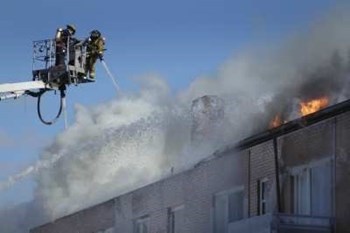
It's a nightmare scenario. From the 1970s-era disaster movie The Towering Infernoto the very real nightmare of 9/11, the idea of being trapped by a raging fire hundreds of feet in the air is nothing anybody wants to contemplate.
High-rise fires are a mercifully rare occurrence, but they do happen. With the proper hardware installed in your building, a clear evacuation plan and some basic tenant knowledge, high-rise fires can be prevented—or survived.
Cause & Effect
James Long, a New York City firefighter of fourteen years currently serving as a spokesman in the FDNY's Office of Public Information, says that the number one cause of fires in any building, high-rise or otherwise, is the preventable accident.
"The four main causes of preventable accidents are: electrical—overloading outlets, improper use of power strips and extension cords, unattended candles left close to combustibles, lighters and matches left in the reach of children, and careless smoking." If more people would regularly check for frayed wires and dangerous electrical outlets in their home, many of these fires could be prevented—which is to say nothing of the number of fires that could be avoided if open flames were a no-no when kids (or careless adults) are around.
According to the New York State Office of Fire Prevention and Control, fire kills more Americans than all other natural disasters combined. In the ten years from 1995–2005, 43,900 people in the U.S. died in fires. On average, there are somewhere around 3,000 serious fires in New York City each year, "serious" being defined as fires declared "all hands" by the FDNY.
High-Rise Fire Specs
And while a candle can set fire to a townhouse as quickly as it can set fire to a high-rise, high-rise buildings on fire behave differently and require slightly different actions by both those dwelling in the building and those who are responsible for ensuring its fire safety. Simply put, more people in high-rise buildings means more potential disaster and fatality. As a result, strict laws are in place to keep high-rises as safe as possible.
"You must consider the great number of people in the general area of the fire," says Long. "While fire in high-rise buildings can for the most part be isolated to an apartment or room in the apartment, the smoke can quickly spread, creating a hazardous environment for many people. The time it could take emergency crews to reach the upper floors of the fire allows the build up of heat and smoke."
Alan Levitt is president of Big Apple Fire Sprinkler Company, Inc., a business he founded in 1983. Levitt, a Master Fire Suppression Contractor licensed by the New York City Buildings Department, says that "if a building has four or more apartments, the sprinkler system must be inspected monthly by someone who has a certificate of fitness issued by the New York City Fire Department. Written records of the inspections must be kept at the building at all times and available to any New York City Fire Department representative who may ask to see them." Levitt warns that there are consequences for buildings that fail the high-rise sprinkler test. "If an FDNY inspector comes to your building and sees that the inspections have been skipped you will be issued a violation. It [is] your responsibility, not the contractors."
Sprinkler check-ups aren't the only check-ups you should schedule, either. A fire-safety system has many parts and they all need to be in working order at all times—after all, fire waits for no man.
"If you have a standpipe in the building, a building employee must obtain a certificate of fitness for the standpipe," says Levitt. "Each building with a Siamese connection on the exterior of the building must have a hydrostatic pressure test every five years. The test is performed by a Licensed Master Fire Suppression Contractor and witnessed by a member of the Fire Department. The test checks the integrity of the system by pumping up the pressure in the piping to two and one half times the street water pressure."
And that's not all. Levitt adds that a flow test is required for every residential sprinkler system every 30 months to check the minimum water pressure and to avoid additional fines. Remember that you have to have backups for everything too. "Spare sprinkler heads, a sprinkler head wrench and all required sprinkler signage must be on the premises or a violation may be issued."
And while a management company can put an employee of the building through training, most people tend to hire out these inspections. "A building employee can take the exam to obtain the certificate of fitness," says Levitt, "but the exam is difficult for someone without thorough knowledge. You can also hire a Licensed Master Fire Suppression Contractor to perform these monthly inspections. The vast majority of buildings in New York City hire a Master Fire Suppression Contractor for the inspections. It's one less thing an apartment owner or manager has to worry about and we can immediately repair any problems that may arise. You cannot hire an outside contractor for the required monthly [standpipe] inspections."
While it may be difficult to get employees trained for certain aspects of fire safety, there are some preventative measures a staff can take for the good of the building besides conducting regular fire drills.
Peter Grech, vice president of education services for the New York Superintendents Technical Association (NYSTA) and a resident manager, says distribute the fire plan, but also go beyond that.
He says for example, that his building sends out the fire plan once a year, according to law. But he also suggests that the staff should take the extra initiative to inform new residents. "When new people move in, we give it to them. But you have to explain it to them. Use the stairwell. Which stairwell? That sort of thing. It's assumed that you know what to do."
Supers and other building employees need to take it upon themselves to get the information they need. The NYSTA is one avenue, offering classes for fire safety certification. NY Fire Consultants, a Staten Island-based fire and life safety consulting firm, and similar organizations conduct classes and do yearly inspections, as well as putting out a (free) email newsletter. And there's always the fire department itself. The FDNY website is a particularly useful resource on fire safety.
Important Hardware—And Beyond
Inspected sprinklers and staff prevention alone aren't half as effective as they are when combined with a few other hardware tools and a building full of informed people.
Michael Rose, the chief executive officer of Academy Fire Protection in Maspeth and New Jersey, says, "Property managers need to educate the occupants on basic building fire protection, [like] how to handle portable fire extinguishers and how to use a standpipe hose. They should also prepare people for the worst and provide a building escape and evacuation plan."
According to Rose, it doesn't take long to learn how a high-rise fire should be handled—and the result of a little knowledge could save lives. "Five minutes a year of review for any of the occupants can really mean the difference between life and death. All types of information on codes and safety recommendations can be found at the National Fire Prevention Association website."
And if your evacuation plan is a little dusty, it's time to get out the feather duster and take a refresher course. "All evacuation plans are good, [but] some are better then others. High-rises have their own particulars—each plan needs to be tailored to the situation."
Long notes that in a high-rise building, keeping the fire as contained as possible is crucial: While you're calmly following your evacuation plan, kindly shut the door. "First, people need to call 911 as soon as possible," he says. "The delay in notifying the first responders allows for the fire or emergency to grow or increase. Secondly, when evacuating the fire apartment, people too often leave without closing the door behind them. This allows the fire to spread into the public hall."
Rose adds that there are more similarities to small building and tall building fire emergencies than there are differences, and common fire-safety sense applies in both. "Many of the same [safety] techniques are prevalent in each. Stop drop and roll if on fire, don't use the elevator, don't panic, make sure other people know of the situation but do not create hysteria, sound an alarm, get out of building, help those that need assistance, and stay low in smoke."
Rose's company helps building managers, boards and shareholders create a water-tight fire safety plan that makes these tips easier to follow. "We walk the site, review the plans, and make sure emergency lighting is working, which is very important. We set up a program and help through the education process and help facilitate NFPA safety course information training. We can help educate those on the requirements by the FDNY for having managers maintain a certificate of fitness for safety equipment."
Bad Ideas, Good Ideas
According to Levitt, fire sprinklers are the most reliable fire protection system you can get. "They have a 99.76 success rate in communities where all fires are reported," he says. "Not only do residential fire sprinkler systems save lives, but they also reduce the incidence of property loss by 85 percent. Even a small fire can render a building unusable. During a fire, flames must be extinguished and smoke damage kept to a minimum, not only for your tenants' safety, but also because making a building habitable after a fire might be a long and costly process."
It's also a bad idea to try and be a hero. "The fire department is who they are for a reason," says Rose. "They get paid and they get trained. They are usually in top physical condition, plus: they have some of the best equipment known to mankind to protect them. It's important the first thing that occurs to you is to sound some sort of an alarm. This summons the people that know how to deal with the situation. Being in New York City, we have the luxury of working with the New York City Fire Department. Some people really don't know how lucky they are."
True; but don't forget that fire safety is everyone's job. If you live in a high-rise building and haven't brushed up on your evacuation plan in a few years (yes, it's been six years since 9/11, believe it or not) the time to do so is now. If you're a building manager who has let the sprinkler system inspections slide by a couple months (or longer), it's time to schedule inspections and do your updates. High-rise fires are essentially like any other fire in a residential structure—destructive, possibly fatal, and often avoidable if safety measures are taken from the sprinklers and tenants—on up.
Mary Fons is a freelance writer and performance artist living in Chicago, Illinois. Greg Olear contributed to the writing of this story.






Comments
Leave a Comment